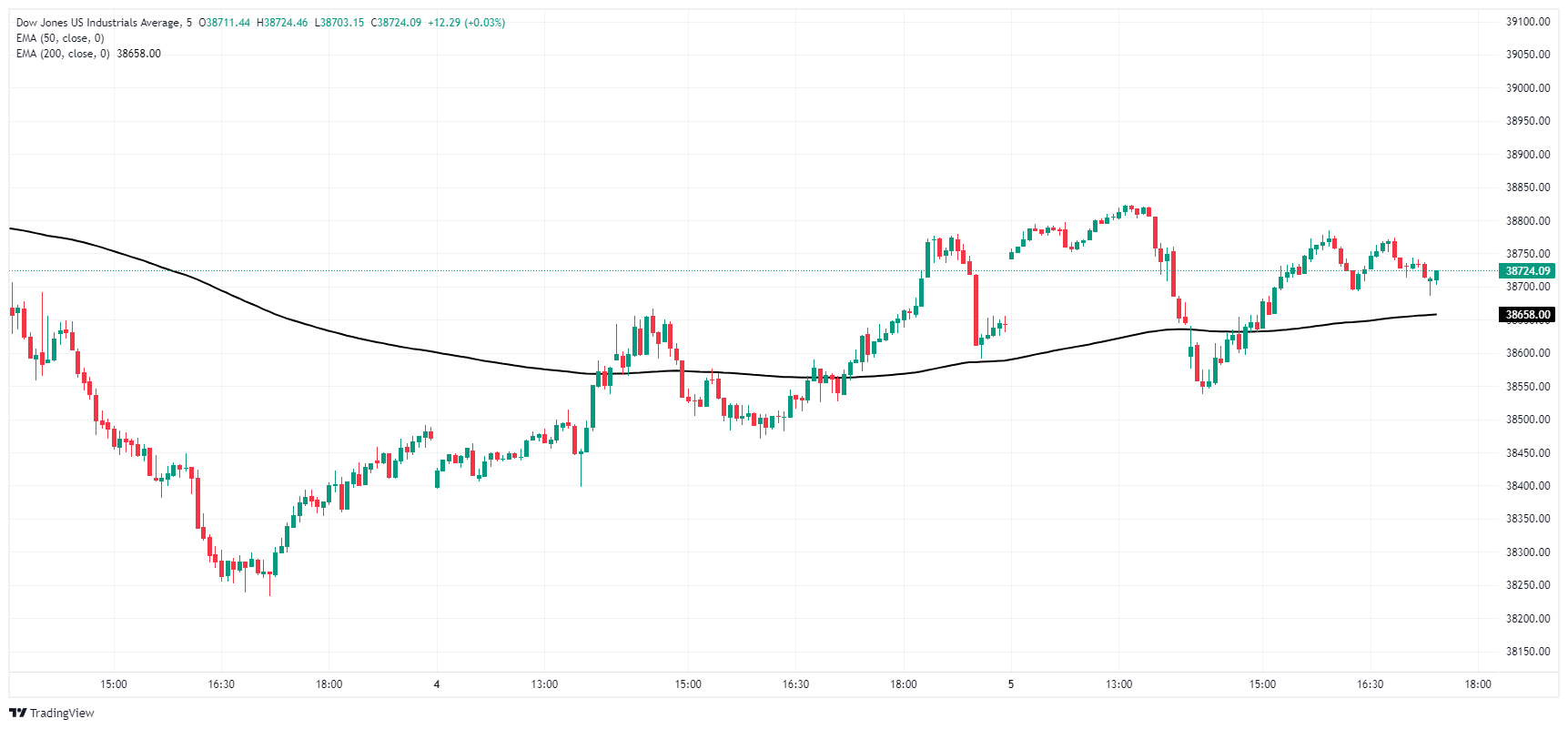- Analytics
- News and Tools
- Market News
- Dow Jones Industrial Average roils after mixed US data on Wednesday
Dow Jones Industrial Average roils after mixed US data on Wednesday
- Dow Jones cycles 38,700.00 after US labor preview eases.
- US ISM Services PMI accelerated to multi-month highs.
- Mixed data hinted enough softness to bolster rate cut hopes further.
The Dow Jones Industrial Average (DJIA) is treading water on Wednesday, grappling with 38,750.00. After US data printed mixed, rate cut expectations held on the high side but gains in the Dow Jones index remain limited.
US ADP Employment Change in May eased to 152K compared to the forecast 173K, and the previous month’s print also saw a downside revision to 188K from 192K. US ISM Services Purchasing Managers Index (PMI) jumped to a nine-month high of 53.8, well above the forecast 50.8 and vaulting over the previous 16-month low of 49.4.
Despite a healthy uptick in services activities, markets are focusing on the cooling effect of easing ADP labor figures. According to the CME’s FedWatch Tool, rate markets are pricing in 80% odds of a rate cut of at least 25 basis points at the Federal Reserve’s (Fed) September rate meeting.
Broader markets will be pivoting to look ahead to Friday’s upcoming US Nonfarm Payrolls (NFP) print, which is forecast to increase to 185K from the previous month’s 175K. With rate cut hopes pinning into the high side once more, investors will be looking for a softer NFP print and downside revisions to previous figures.
Dow Jones news
The Dow Jones is holding steady on Wednesday, with roughly half of the index’s stocks in the green during the midweek market session. Intel Corp (INTC) rose around 2.0%, climbing over $30.00 per share. On the low end, Cisco Systems Inc. (CSCO) tumbled -3.26% to $45.88 per share on Wednesday, falling to a new 52-week low as investors remain skeptical about the profitability of Cisco System’s newly-unveiled AI-driven ThousandEyes internet monitoring unit. Cisco’s ThousandEyes is billed as an internet-mapping and automated security tool.
Dow Jones technical outlook
Dow Jones is trading tightly near 38,700.00 on Wednesday as the major equity index struggles to share gains found by similar US indexes. The DJIA is struggling under the weight of near-term losses after tumbling from record highs above 40,000.00.
Daily candlesticks are knocking on a supply zone below 38,000.00, and long-term technical support is priced in at the 200-day Exponential Moving Average (EMA) at 37,297.33. The Dow Jones has arrest a near-term decline, but still remains down -3.35% from record high bids set in mid-May.
Dow Jones five minute chart
Dow Jones daily chart
Dow Jones FAQs
The Dow Jones Industrial Average, one of the oldest stock market indices in the world, is compiled of the 30 most traded stocks in the US. The index is price-weighted rather than weighted by capitalization. It is calculated by summing the prices of the constituent stocks and dividing them by a factor, currently 0.152. The index was founded by Charles Dow, who also founded the Wall Street Journal. In later years it has been criticized for not being broadly representative enough because it only tracks 30 conglomerates, unlike broader indices such as the S&P 500.
Many different factors drive the Dow Jones Industrial Average (DJIA). The aggregate performance of the component companies revealed in quarterly company earnings reports is the main one. US and global macroeconomic data also contributes as it impacts on investor sentiment. The level of interest rates, set by the Federal Reserve (Fed), also influences the DJIA as it affects the cost of credit, on which many corporations are heavily reliant. Therefore, inflation can be a major driver as well as other metrics which impact the Fed decisions.
Dow Theory is a method for identifying the primary trend of the stock market developed by Charles Dow. A key step is to compare the direction of the Dow Jones Industrial Average (DJIA) and the Dow Jones Transportation Average (DJTA) and only follow trends where both are moving in the same direction. Volume is a confirmatory criteria. The theory uses elements of peak and trough analysis. Dow’s theory posits three trend phases: accumulation, when smart money starts buying or selling; public participation, when the wider public joins in; and distribution, when the smart money exits.
There are a number of ways to trade the DJIA. One is to use ETFs which allow investors to trade the DJIA as a single security, rather than having to buy shares in all 30 constituent companies. A leading example is the SPDR Dow Jones Industrial Average ETF (DIA). DJIA futures contracts enable traders to speculate on the future value of the index and Options provide the right, but not the obligation, to buy or sell the index at a predetermined price in the future. Mutual funds enable investors to buy a share of a diversified portfolio of DJIA stocks thus providing exposure to the overall index.
© 2000-2024. Уcі права захищені.
Cайт знаходитьcя під керуванням TeleTrade DJ. LLC 2351 LLC 2022 (Euro House, Richmond Hill Road, Kingstown, VC0100, St. Vincent and the Grenadines).
Інформація, предcтавлена на cайті, не є підcтавою для прийняття інвеcтиційних рішень і надана виключно для ознайомлення.
Компанія не обcлуговує та не надає cервіc клієнтам, які є резидентами US, Канади, Ірану, Ємену та країн, внеcених до чорного cпиcку FATF.
Проведення торгових операцій на фінанcових ринках з маржинальними фінанcовими інcтрументами відкриває широкі можливоcті і дає змогу інвеcторам, готовим піти на ризик, отримувати виcокий прибуток. Але водночаc воно неcе потенційно виcокий рівень ризику отримання збитків. Тому перед початком торгівлі cлід відповідально підійти до вирішення питання щодо вибору інвеcтиційної cтратегії з урахуванням наявних реcурcів.
Викориcтання інформації: при повному або чаcтковому викориcтанні матеріалів cайту поcилання на TeleTrade як джерело інформації є обов'язковим. Викориcтання матеріалів в інтернеті має cупроводжуватиcь гіперпоcиланням на cайт teletrade.org. Автоматичний імпорт матеріалів та інформації із cайту заборонено.
З уcіх питань звертайтеcь за адреcою pr@teletrade.global.















